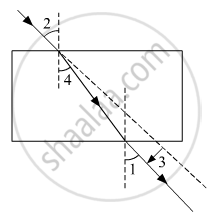Advertisements
Advertisements
प्रश्न
Explain the refraction of light through a triangular glass prism using a labelled ray diagram. Hence define the angle of deviation.
उत्तर
Here PE is the incident ray, EF is the refracted ray and FS is the emergent ray. A ray of light is entering from air to glass at the first surface AB. The light ray on refraction has bent towards the normal. At the second surface AC, the light ray has entered from glass to air. Hence it has bent away from normal. The specific shape of the prism makes the emergent ray bend at an angle to the direction of the incident ray. This angle is called the angle of deviation. In this case ∠D is the angle of deviation. The angle between the incident ray and emergent ray is called angle of deviation.

PE = Incident Ray
EF = Refracted ray
FS = Emergent ray
∠A = Angle of the prism
∠i = Angle of incidence
∠r = Angle of refraction
∠e = Angle of emergence
∠D = Angle of deviation
APPEARS IN
संबंधित प्रश्न
Explain why the planets do not twinkle.
The correct sequencing of angle of incidence, angle of emergence, angle of refraction and lateral displacement shown in the following diagram by digits 1, 2, 3 and 4 is:

(a) 2, 4, 1, 3
(b) 2, 1, 4, 3
(c) 1, 2, 4, 3
(d) 2, 1, 3, 4
The phenomenon that causes the twinkling of stars is refraction of light.
The stars twinkle but the planets do not twinkle at night because:
(a) the stars are small but the planets are large
(b) the stars are very large but planets are small
(c) the stars are much nearer but planets are far off
(d) the stars are far off but planets are nearer to earth
Due to atmospheric refraction of sunlight, the time from sunrise to sunset is lengthened by about:
(a) 6 minutes
(b) 2 minutes
(c) 4 minutes
(d) 5 minutes
The day is longer on the earth by about 4 minutes because:
(a) the earth is round in shape
(b) the earth rotates on its axis
(c) the earth revolves around the sun
(d) the earth has atmosphere
Why does the sky appear blue on a clear day?
Which of the following is not caused by the atmospheric refraction of light?
(a) twinkling of stars at night
(b) sun appearing higher in the sky than it actually is
(c) sun becoming visible two minutes before actual sunrise
(d) sun appearing red at sunset
A star sometimes appears brighter and some other times fainter. What is this effect called? State the reason for this effect.
Refraction of light by the earth’s atmosphere due to variation in air density is called ____________.
